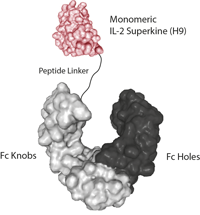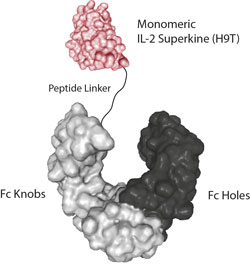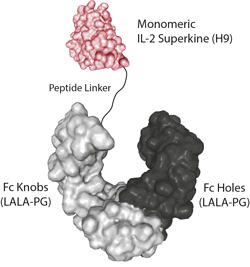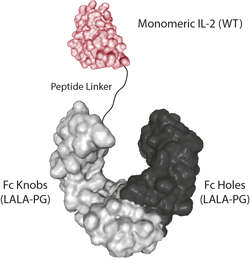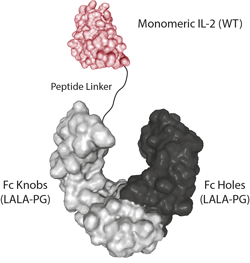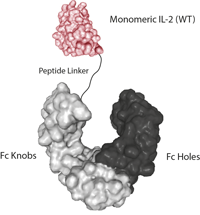
Protein Structure
IL-2 (human) (monomeric):Fc-KIH (human) (rec.)
AG-40B-0224
Product group Proteins / Signaling Molecules
Overview
- SupplierAdipoGen Life Sciences
- Product NameIL-2 (human) (monomeric):Fc-KIH (human) (rec.)
- Delivery Days Customer7
- CertificationResearch Use Only
- Estimated Purity>95%
- Scientific DescriptionInterleukin-2 (IL-2) is a 133 amino acid glycoprotein with one intramolecular disulfide bond and variable glycosylation. It is secreted by activated T cells and induces proliferation and maturation of activated T cells, natural killer cells and lymphokine activated killer cells. IL-2 also stimulates proliferation of antibody-producing B cells, activates neutrophils and induces mononuclear cells to secrete IFN-gamma and TNF-alpha and -beta. Moreover, studies have shown that IL-2 is required for activation-induced apoptosis, an important homeostatic mechanism in the immune system, which is involved in the maintenance of peripheral tolerance to self-antigens.IL-2 promotes T cell proliferation and particularly naive T cells. IL-2 signaling on activated T cells is effected through a quaternary high-affinity receptor complex consisting of IL-2, IL-2Ralpha (CD25), IL-2Rbeta and IL-2Rgamma. Naive T cells are relatively insensitive to IL-2 as they only express small amounts of IL-2Rbeta and IL-2Rgamma. They only acquire sensitivity after CD25 expression, which captures the cytokine and presents it to the IL-2Rbeta and IL-2Rgamma receptors. IL-2 is used in the treatment of metastatic cancer cells. Recently synergy has been observed between IL-2 based therapy and checkpoint blockade for cancer treatments. Cells which bear receptors for IL-2 stimulation are modulated by checkpoint inhibition either directly or through other lymphocytes, and lymphocytes which are effectors of checkpoint inhibition may respond to IL-2. The protein IL-2 (human) (monomeric):Fc-KIH (human) (rec.) is produced by using two different vectors, one encoding for the IL-2 (human):Fc Knobs sequence (synthesizing a protein of 45kDa) and one encoding for the Fc Holes sequence (synthesizing a protein of 28kDa). Both vectors transfected into HEK293 cells produce both Fc molecules (Knobs-into-Holes technology; J.B. Ridgway, et al.; Protein Eng. 9, 617 (1996)) required for dimerization of the Fc moieties and for secretion of the final protein IL-2 (human) (monomeric):Fc-KIH (human) (rec.). InVivoKines™ are a new generation of recombinant fusion proteins for immunotherapeutic, preclinical and translational in vivo research, developed and manufactured by AdipoGen Life Sciences. - InVivoKines™. Recombinant Protein. Human IL-2 (aa 21-153) is fused at the C-terminus to the Fc portion of human IgG1 (Knobs-into-Holes technology) (see reference: J.B. Ridgway, et al.; Protein Eng. 9, 617 (1996)). Source: HEK 293 cells. Lyophilized. Contains PBS. Interleukin-2 (IL-2) is a 133 amino acid glycoprotein with one intramolecular disulfide bond and variable glycosylation. It is secreted by activated T cells and induces proliferation and maturation of activated T cells, natural killer cells and lymphokine activated killer cells. IL-2 also stimulates proliferation of antibody-producing B cells, activates neutrophils and induces mononuclear cells to secrete IFN-gamma and TNF-alpha and -beta. Moreover, studies have shown that IL-2 is required for activation-induced apoptosis, an important homeostatic mechanism in the immune system, which is involved in the maintenance of peripheral tolerance to self-antigens.IL-2 promotes T cell proliferation and particularly naive T cells. IL-2 signaling on activated T cells is effected through a quaternary high-affinity receptor complex consisting of IL-2, IL-2Ralpha (CD25), IL-2Rbeta and IL-2Rgamma. Naive T cells are relatively insensitive to IL-2 as they only express small amounts of IL-2Rbeta and IL-2Rgamma. They only acquire sensitivity after CD25 expression, which captures the cytokine and presents it to the IL-2Rbeta and IL-2Rgamma receptors. IL-2 is used in the treatment of metastatic cancer cells. Recently synergy has been observed between IL-2 based therapy and checkpoint blockade for cancer treatments. Cells which bear receptors for IL-2 stimulation are modulated by checkpoint inhibition either directly or through other lymphocytes, and lymphocytes which are effectors of checkpoint inhibition may respond to IL-2. The protein IL-2 (human) (monomeric):Fc-KIH (human) (rec.) is produced by using two different vectors, one encoding for the IL-2 (human):Fc Knobs sequence (synthesizing a protein of 45kDa) and one encoding for the Fc Holes sequence (synthesizing a protein of 28kDa). Both vectors transfected into HEK293 cells produce both Fc molecules (Knobs-into-Holes technology; J.B. Ridgway, et al.; Protein Eng. 9, 617 (1996)) required for dimerization of the Fc moieties and for secretion of the final protein IL-2 (human) (monomeric):Fc-KIH (human) (rec.).
- Storage Instruction-20°C,2°C to 8°C
- UNSPSC12352202

![IL-2 Superkine (Fc) [IL-2 (human):Fc (human) (rec.)]](https://adipogen.com/pub/media/catalog/product/a/g/ag-40b-0111-superkine_elisa-new.jpg)
